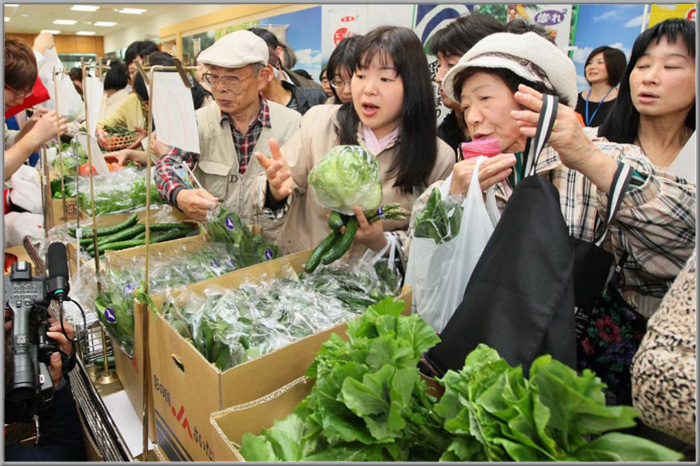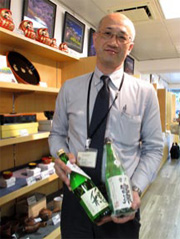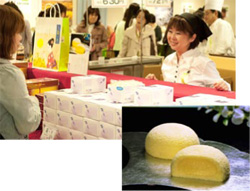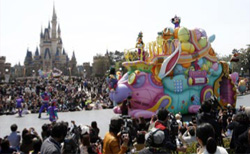Home > Highlighting JAPAN > Highlighting Japan MAY 2011 > Returning in Numbers
Highlighting JAPAN
COVER STORY: The Road to Recovery
Customers shop for farm products at the Japan Agricultural Cooperatives (JA) building in Chiyoda Ward, Tokyo, April 14. JA held the event to support farmers in disaster-affected areas such as Chiba, Ibaraki, and Fukushima Prefectures. These vegetables are not subject to shipment restrictions.
Credit: YUSUKE NAKANISHI/AFLO
Returning in Numbers
Consumers in the capital have gone out of their way to back businesses badly hit by the March 11 quake and tsunami.

Junya Tomita, director of Fukushima Yaesu Tourism and Exchange Center, holding sake from Fukushima.
Credit: AIZAWA TADASHI
Fukushima Yaesu Tourism and Exchange Center
In central Tokyo, many prefectures, cities or other local municipalities have set up showrooms for promoting tourism and selling local specialties. The Fukushima Yaesu Tourism and Exchange Center near Tokyo Station specializes in products from Fukushima Prefecture, stocking a range of more than 300 local products including sake, honey, miso, and folk crafts.
Fukushima Prefecture was heavily damaged by the March 11 earthquake and tsunami, and even now, part of the prefecture has been designated an evacuation zone and produce grown in some areas is subject to the government's shipment restrictions following the accident at the nuclear power plant.
Every day since the disaster, the Center has been crowded with people supporting Fukushima Prefecture by purchasing local products. Normally, fruit and vegetables are not sold at the Center, but on April 2 and 3, there was a sale of produce from Fukushima Prefecture, including strawberries, asparagus and cucumber grown in areas that are not subject to shipment restrictions and that are found to be below the legal limit in tests to monitor radioactivity. A long line of shoppers formed before the 10:00 start of the sale and all produce sold out in about fifteen minutes.
More than 1,200 people come to the store on a weekday, or three times the number before the earthquake disaster. The store has been forced to limit entry with weekend visitors to the shop numbering about 1,500 people. A collection box was placed at the cash register the day after the earthquake, and had raised approximately 10 million yen by the end of April. Half the people visiting the shop have no direct links to Fukushima. On April 21, the U.S. Ambassador to Japan, John Roos, visited the Center to purchase sake.
Junya Tomita, director of the Center, comments, "We have also received a lot of requests from people asking us to sell products from Fukushima Prefecture at the stall in concerts and festival venues without paying the usual charge to open the stall."
It is also possible to read newspapers published in Fukushima Prefecture at the Center. Serving as a point of contact between Tokyo and Fukushima, the store also posts extensive information about transportation access from Tokyo to Fukushima and about the locations of evacuation centers.
Visiting the store, a woman in her twenties, who is a native of Fukushima Prefecture but lives in Tokyo, commented, "Fortunately, my parents' home in Fukushima was not damaged in the earthquake and my mother tells me that things have settled down. I am buying sake from Fukushima at this store to send to friends in Kyushu. I do it because I would like them to think a little bit about Fukushima."
A woman in her sixties who moved from Fukushima to Chiba Prefecture three years ago said, "I also do some fundraising, but by buying products at this store, I think I can help Fukushima, if only a little. I am very happy that so many people are coming to the store."

Kumiko Nihei (right) sells Hagi no tsuki at Takashimaya department store in Shinjuku, Tokyo. Hagi no tsuki is a sponge cake resembling a full moon. Hagi (bush clover) is the symbol flower of Miyagi Prefecture.
Credit: MASATOSHI SAKAMOTO, COURTESY OF KASHO SANZEN
Shinjuku Takashimaya
Shinjuku Takashimaya is a major department store in central Tokyo, receiving approximately 100,000 shoppers a day on the weekends. From April 20 to 25, the store organized a fair at its event space to sell more than 120 products, including sweets, meat and pickles, from Miyagi Prefecture where the heavy damage sustained in the East Japan Great Earthquake was centered on coastal areas.
The store's Tomoyuki Sato explains, "We wanted to do something for Miyagi Prefecture where the damage was so extensive. So we talked to producers and the outcome was to organize the Miyagi Fair at Shinjuku Takashimaya to sell appealing products from the area." Although the decision to organize the fair was made in the end of March, it was not clear whether the stallholders who had decided to participate would be able to produce sufficient products, or whether they would be able to bring the products to Tokyo since both logistics and power supplies were unstable due to the impact of the aftershocks in Miyagi Prefecture, so no one involved in the project was able to relax until immediately before the event. However, a selection of products was made available as planned and since the fair received extensive coverage on television and in the newspapers, there were crowds of shoppers every day.
Sato commented, "Once again, I experienced the fundamentals of the retail trade, which is to connect with producers and customers."
One very popular product at the Fair was Hagi no tsuki (literally, bush clover moon) made by Kasho Sanzen, a manufacturer of sweets in Sendai. A well-known sweet almost synonymous with Miyagi Prefecture, Hagi no tsuki is an airy sponge cake filled with custard. Since the manufacturing equipment at the factory had toppled and there were power and water supply outages immediately after the earthquake, production of the confectionery was temporarily suspended, and the company had no choice but to close the stores under direct management. However, wanting to offer confectionery to people worn out by the earthquake disaster, the company started to sell its inventory at the stores that were able to open on the second day after the disaster.
Today, both production quantities and the number of operating stores have just about returned to pre-disaster levels. The Shinjuku Takashimaya Fair also had streams of visitors who came to buy the Hagi no tsuki confectionery.
"Many customers told us to keep it up and said that they were happy to be able to buy Hagi no tsuki here," comments Kumiko Nihei of Kasho Sanzen who participated in the Shinjuku Takashimaya Fair. "When I go back to Miyagi, I will take these messages to the people at our factory."

Disney character Mickey Mouse performs atop a float during a parade at Tokyo Disneyland, April 15.
Credit: REUTERS/AFLO
Tokyo Disneyland
Tokyo Disneyland, which had been closed since the earthquake on March 11, opened again for business on April 15. On the day, there were about 10,000 people waiting for the 8:00 opening, including people who had lined up from the night before. As of April 23, the attraction had extended its operating hours until 22:00, as was the case before the disaster, and on April 24, the popular Electrical Parade Dream Lights was restarted with many visitors enjoying the glittering lights of the evening parade. For the reopening, the operators of Tokyo Disneyland, Oriental Land Co., released a statement saying, "We will continue to strive toward providing an experience filled with dreams and happiness to as many guests as possible, and will make our best corporate effort to answer the needs and expectations of as many people as possible."
Disney Sea, which is adjacent to Disneyland, also reopened for business on April 28.
© 2009 Cabinet Office, Government of Japan






